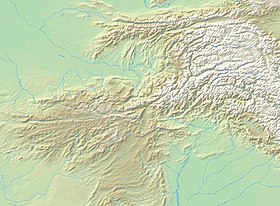Lawik dynasty | |||||||||||||
|---|---|---|---|---|---|---|---|---|---|---|---|---|---|
| c.750 CE–977 CE | |||||||||||||
Ghazni was the power-center of the Lawik dynasty. Citadel of Ghazni pictured above
| |||||||||||||
| Capital | Ghazni | ||||||||||||
| Religion | Hinduism[1] (before 782)
Islam[2] (after 782) | ||||||||||||
| Government | Monarchy | ||||||||||||
| Historical era | Early Middle Ages | ||||||||||||
• Established | c.750 CE | ||||||||||||
• Disestablished | 977 CE | ||||||||||||
| |||||||||||||
| Today part of | Afghanistan | ||||||||||||
The Lawīk dynasty was the last native dynasty which ruled Ghazni prior to the Ghaznavid conquest in the present-day Afghanistan. Lawiks were originally Hindus, but later became Muslims.[2] They were closely related to the Hindu Shahis,[3] and after 877, ruled under the Hindu Shahi suzerainty.[4]
A branch of Lawiks ruled the nearby city of Gardez.[3] The Siyasatnama of Nizam al-Mulk, the Tabaqat-i Nasiri of Juzjani, and the Majma' al-ansāb fī't-tawārīkh of Shabankara'i (14th century) mentioned Lawiks.[5]
- ^ Jan, Changez (18 July 2022). Forgotten Kings: The Story of the Hindu Sahi Dynasty. Simon and Schuster. ISBN 978-93-92099-01-4.
- ^ a b Clifford Edmund Bosworth (1977). The Medieval History of Iran, Afghanistan, and Central Asia. Variorum Reprints. pp. 301–302.
- ^ a b Unesco (1 January 1998). History of Civilizations of Central Asia. UNESCO. p. 96. ISBN 978-92-3-103467-1.
- ^ Cite error: The named reference
owas invoked but never defined (see the help page). - ^ Alikuzai, Hamid Wahed (1 October 2013). A Concise History of Afghanistan in 25 Volumes. ISBN 978-1-4907-1441-7.


